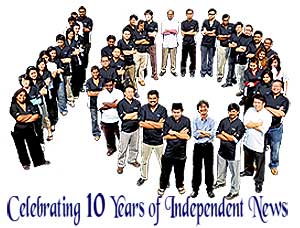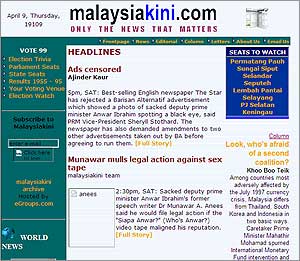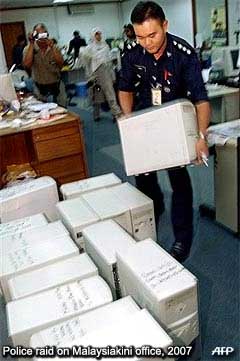About six or seven years ago, one of the Malaysiakini editors invited me to write a weekly column for them.
Since then, I have been very committed to my new vocation of writing commentary on the Internet, first for Malaysiakini , and then for some other publications as well.
Except for those occasional lapses brought on by writer's block, bad health, and emergencies, I have always tried to keep to the deadline for Malaysiakini .
Steven Gan and his editorial gang in Bangsar Utama have never told me what to and not to write. They have never changed anything in my writing, except for corrections for typographical mistakes.
They have once or twice rung up to check my facts. I tell you this: Malaysiakini is a writer's paradise in Malaysia!
 They never paid me enough, but that is alright. I heard they started making their first profit only in the eighth or ninth year of their existence.
They never paid me enough, but that is alright. I heard they started making their first profit only in the eighth or ninth year of their existence.
I can only imagine their anguish month after month, year after year, in all those early years worried about paying bills and salaries.
I will only ask for a raise in my writing fees when Malaysiakini is publicly listed on the KLSE. You may laugh!
When I told my friends in my neighbourhood coffee shop over a few bubblies that tickets for the Malaysiakini 10th Anniversary big bash at the Sime Darby Convention Centre in Bukit Kiara on Nov 28 are priced at RM2,000, RM1,000, RM500 and RM100, they expressed their doubt whether there would be so many expensive tickets sold.
The Malaysiakini team would be used to this sort of public cynicism by now.
When Gan and Premesh Chandran presented their proposal in 1999 to set up an Internet newspaper that would aspire to international standards of journalistic excellence, such as "credibility, independence, fairness and accuracy", people then must have also been sceptical about the prospect of such a new media organisation.
It simply had never existed in Malaysia, right up to that point.
Hungry for a different kind of news
When they also proposed boldly to strike at financial independence based on revenues from advertisements and subscriptions, people scoffed at the ideas.
In those early days of the Internet in Malaysia, people expected to get everything on the Internet for free, and the commercial power of the Internet market had yet to be released to the world.
In 1999, it was indeed a bold idea for a new media business model that had never been tried. But it made sense.
An Internet newspaper does not need the kind of monstrous capital outlay as do the print and electronic media. You need no expensive printing machine, no news print, no massive staff, and no distribution and delivery system.
The maintenance and administration costs will be kept at a minimum. The founders were optimistic that with advertisement revenues, the company would likely be self-sufficient in a year and return profits within two years.
 Malaysiakini
went live on Nov 20, 1999, on the nomination day of a general election.
Malaysiakini
went live on Nov 20, 1999, on the nomination day of a general election.
It caught the feverish mood of the people hungry for a different kind of news, and was soon swallowed by the public like hot cakes, especially by the reformasi audience.
But the birth of Malaysiakini was not without pain.
Malaysiakini has since become one of the case studies in the book by Cherian George entitled Contentious journalism and the Internet: Towards democratic discourse in Malaysia and Singapore (published by National University of Singapore Press in association with University of Washington Press, 2006).
This is what the book says about the beginning of Malaysiakini: "The company obtained much of its start up capital from abroad. The Bangkok based Southeast Asian Press Alliance (Seapa) gave a grant of US$100,000. The Media Development Loan Fund (MDLF) based in New York paid the company US$188,000 to build a software application. In 2002, MDLF invested US$1.3 million for a 29 percent equity stake.
"A disgruntled former employee revealed that the website had received money from the American financier, George Soros. The link was slim and indirect; George Soros' Open Society Institute was one of the groups behind MDLF."
This allowed Malaysiakini critics, especially those in the BN government, to question the loyalty of the portal. Soros was blamed for the financial meltdown in Malaysia and Southeast Asia in 1997.
 The mood of the nation then was definitely nationalistic. The Malaysian prime minister at that time Dr Mahathir Mohamad (
left
) said: "People who love Malaysia will not support
Malaysiakini
."
The mood of the nation then was definitely nationalistic. The Malaysian prime minister at that time Dr Mahathir Mohamad (
left
) said: "People who love Malaysia will not support
Malaysiakini
."
Fortunately for Internet journalism, Dr M had promised the international community not to censor the Internet in order to attract foreign investors to his pet project launched amidst great fanfare: The Multimedia Super Corridor.
Gan and Chandran protested that their financial backers have no editorial influence on the site, and they made MDLF sign a pledge of non-interference, while limiting foreign equity to under 30 percent.
What they did was historic for the Malaysian media industry. In Malaysia, investors pump in money and control the editorial policy of the media, to make money and to pursue a political agenda.
They would laugh at something like editorial independence, which ought to be the hallmark of good journalism. The Guardian of the United Kingdom certainly has always enjoyed non-interference from their owners.
Perhaps the demonisation of Malaysiakini by the government had taken its toll. They did not receive the advertising revenues that they anticipated. Then again, perhaps Netizens in those early days of the Internet in Malaysia expected everything to be free on the Internet.
As a commercial venture aiming at financial self-sufficiency, Malaysiakini did look wobbly in the beginning.
Finally, Malaysiakini made the choice to make the website available only to paying subscribers in February 2002. Standard subscription rates were RM10 a month and RM100 per year.
'We get the media we deserve'
It was a bold and desperate move. If my memory serves me right, there was not an online news organisation that could survive commercially without offline help (as was the case with Harakah ) right up till that time.
Looking back, Gan's announcing the end of free Malaysiakini content was a plaintive appeal for readers' participation and support to keep independent journalism alive in Malaysia.
As he wrote at that time, "And when all is said and done, we get the media we deserve."
The response was not overwhelming. By early 2003, Malaysiakini had a subscribers base of 2,000, when they needed 10,000 to survive. It looked as if idealism and noble aims in journalism were about to succumb to the market forces of consumerism based on self-interest, greed, and indifference.
I thought at that time that Malaysiakini was going to lock up its door!
 Then something happened in the history of our nation which seemed insignificant and expected at that time, and which had totally unexpected consequences that helped change the history of our nation in no small way.
Then something happened in the history of our nation which seemed insignificant and expected at that time, and which had totally unexpected consequences that helped change the history of our nation in no small way.
One Monday in January 2003, 10 police officers marched into the Malaysiakini office, carted away 19 of their computers, and practically shut down Malaysiakini .
Malaysiakini came alive again within 10 hours of the shutdown, using different servers at another location. It is often said that we do not appreciate the value of something until we are on the point of losing it.
The police raid revealed to the Malaysian public the dismal prospect of a Malaysia without Malaysiakini . The waves of support from nameless readers poured in, offering loan of computers and donation of cash.
Malaysiakini no longer just reported news; they were in the news - in the region, and throughout the world. World media attention was suddenly turned onto a member of their own, struggling to bring independent journalism to a region not known for press freedom, and yet trying to squeeze onto the Internet bandwagon.
The police raid was to prove to be a blessing in disguise, as Malaysiakini turned the corner.
[To be continued next Saturday...]
SIM KWANG YANG can be reached at [email protected] . Be at the Malaysiakini 10th year anniversary gala dinner. Seats available from RM100. Click here for more information.

